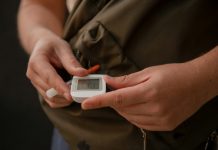
Borderline diabetes, commonly known as prediabetes, is a wake-up call, signaling that your blood sugar levels are higher than normal but not yet high enough to be classified as type 2 diabetes.
This condition affects millions of people worldwide, many of whom are unaware they have it.
Understanding prediabetes is crucial because it offers a critical window of opportunity to make lifestyle changes that can help avert the development of type 2 diabetes.
This review explores what prediabetes is, its symptoms, causes, and the best ways to manage or treat it.
Prediabetes often flies under the radar because it doesn’t always produce clear symptoms. When symptoms do appear, they can be so mild that they’re easily overlooked.
Some people might notice darker areas of skin on parts of their bodies subjected to friction, like the neck or armpits, a condition known as acanthosis nigricans.
Others might experience increased thirst, more frequent urination, fatigue, or blurred vision—symptoms that are easy to attribute to other causes.
The causes of prediabetes are closely linked to those of type 2 diabetes. Genetics plays a role; if you have a family history of diabetes, your risk increases. However, lifestyle factors have a significant impact.
Excess weight, particularly around the abdomen, increases the likelihood of insulin resistance, where your body’s cells don’t respond effectively to insulin, leading to higher blood sugar levels.
Physical inactivity and certain dietary patterns, like consuming high amounts of sugar and processed foods, also contribute to the development of prediabetes.
Research shows that without intervention, people with prediabetes are at risk of developing type 2 diabetes within five years.
However, this progression is not inevitable. Studies, including the landmark Diabetes Prevention Program (DPP) study, have demonstrated that prediabetes can often be reversed through lifestyle changes.
The DPP study found that participants who lost a modest amount of weight (5 to 7% of their body weight) through dietary changes and increased physical activity reduced their risk of developing diabetes by 58%.
Treatment for prediabetes focuses on these lifestyle changes. Eating a balanced diet rich in fruits, vegetables, whole grains, and lean proteins can help manage blood sugar levels.
Regular physical activity, such as brisk walking for 150 minutes a week, has been shown to significantly improve blood sugar control.
For some, medication might be recommended to help manage blood sugar levels, but lifestyle changes remain the cornerstone of prediabetes management.
In addition to lifestyle modifications, regular monitoring of blood sugar levels is vital for people with prediabetes. This can help gauge the effectiveness of the interventions and adjust strategies as needed.
In conclusion, borderline diabetes serves as a critical alert that should not be ignored. By recognizing the signs early and taking proactive steps towards healthier lifestyle choices, individuals can significantly reduce their risk of developing type 2 diabetes.
The journey from prediabetes to a healthier life begins with awareness, followed by action. With the right information and support, reversing prediabetes is an achievable goal, offering a path to a healthier future without diabetes.
If you care about diabetes, please read studies that not all whole grain foods could benefit people with type 2 diabetes, and green tea could help reduce death risk in type 2 diabetes.
For more information about health, please see recent studies about unhealthy plant-based diets linked to metabolic syndrome, and results showing Mediterranean diet could help reduce the diabetes risk by one third.
Copyright © 2024 Knowridge Science Report. All rights reserved.



